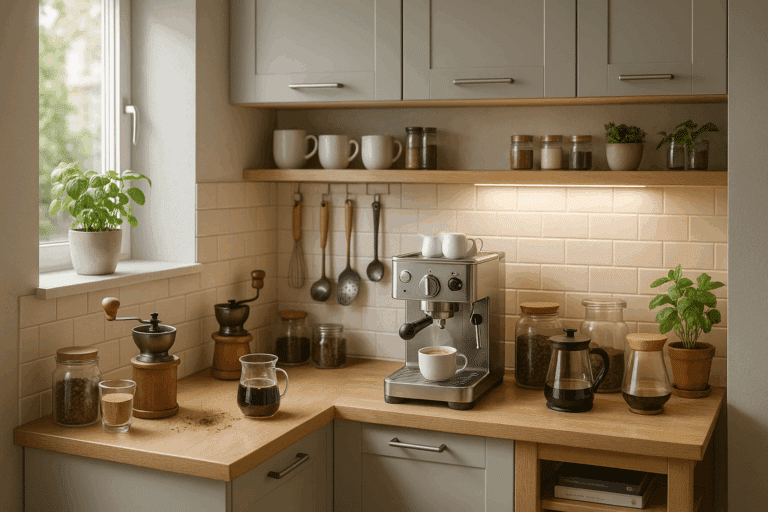In the vast universe of coffee connoisseurs, a significant debate continues to percolate: the quest for the perfect coffee grinder. The stakes are high – after all, we’re talking about the key to unlocking a divine elixir that powers daily life for millions. It’s not just a beverage; it’s a ritual, a comfort, a creative stimulant, and even an art form. So, what’s the secret to elevating your coffee experience to perfection? A burr grinder. 😎
At this point, you might be wondering: “What makes a burr grinder so special?”. It’s a valid question, and one that we will explore in depth throughout this comprehensive guide. We’ll delve into the mechanics of burr grinders, how they compare to their blade counterparts, and why they are a game-changer in the realm of coffee making. We’ll also walk you through a curated selection of the top burr grinders in the market, and teach you how to use one to achieve an unparalleled flavor profile. ☕
Unlike blade grinders, burr grinders provide uniformity and control in the coffee grinding process. Imagine the difference between chopping a pile of ingredients with a cleaver versus meticulously dicing them with a finely honed chef’s knife. The same applies to coffee grinding. The precision of a burr grinder ensures that all the coffee particles are evenly ground to the exact size that you want. This might seem trivial, but it is this consistency that translates to a perfect balance of flavors in your cup.
Why Burr Grinders? 🤔
Consistency is the watchword when it comes to burr grinders. However, the advantages of a burr grinder extend beyond just consistency. In this guide, we’ll delve into how burr grinders maintain the natural oils and flavors of the coffee beans, enhance the extraction process, and contribute to a superior cup of Joe. Whether you’re a seasoned coffee connoisseur or a novice in the world of coffee, this guide will provide you with insights that will change the way you view your daily brew.
As we delve into the world of burr grinders, we will also be exploring the diverse range of options available in the market. From manual grinders for the hands-on coffee enthusiast, to electric grinders for the busy bees – we will cover it all.
Let’s Get Grinding! 😉
Finally, we will step into the practical arena and discuss how to use a burr grinder to unlock the ultimate flavor. With the right knowledge and a little practice, you will be able to take full control of your coffee grinding process, ensuring that every cup of coffee you brew is a testament to perfection.
So, are you ready to elevate your coffee experience to new heights? Are you prepared to journey through the technicalities of a burr grinder and emerge with a newfound appreciation for the art of coffee making? If yes, then this guide is your passport to a world of sublime coffee experiences.🚀
Before we embark on this journey, let’s set the stage. Picture this: it’s a quiet morning, the sun is just starting to peek over the horizon, and the smell of fresh coffee wafts through the air. You take a sip from your cup, and a symphony of flavors dances on your tongue. That, my friend, is the power of a perfectly brewed coffee, made possible by a burr grinder. Let’s discover how to make this dreamy morning scenario a reality.🌅
Unlocking the Ultimate Flavor: Understanding the Magic of Burr Grinders
For coffee enthusiasts, a perfect cup of joe is a symphony of flavors, where each note must play its part flawlessly. It’s a delicate balance that hinges on many variables: the quality of the beans, the brewing technique, and not least, the grind. Enter the Burr Grinder, a coffee aficionado’s best-kept secret and your ticket to a heavenly coffee experience. In this article, we will demystify this coffee gadget, and help you understand why it should be an essential part of your coffee brewing arsenal.
Burr grinders offer consistency, versatility, and control, key elements to extracting the ultimate flavor from your coffee beans. By understanding how this machine works and learning how to use it effectively, you can elevate your coffee experience to a whole new level.
At first glance, a burr grinder may look like just another kitchen gadget. But delve a little deeper, and you will discover a tool that embodies the science and art of coffee grinding. Its magic lies in its design: two abrasive surfaces (the burrs) that grind the beans in a uniform and consistent manner. This uniformity is critical in achieving a balanced extraction, which, in turn, translates into a perfect cup of coffee.
Comparing Burr Grinders with Blade Grinders: A Game of Consistency
Before we delve further into the world of burr grinders, let’s take a moment to understand how they stack up against their primary competitor – blade grinders. While both types of grinders serve the same purpose (i.e., grinding coffee beans), the way they achieve this differs significantly.
Blade grinders are similar to blenders, with a set of blades that spin rapidly to chop the beans. The result is a somewhat inconsistent grind, with a mix of large and small particles. On the other hand, burr grinders crush the beans between the two burrs to a uniform size. This results in a consistent grind, which is crucial for extracting the optimal flavor from the beans.
| Burr Grinder | Blade Grinder | |
|---|---|---|
| Consistency | Excellent | Poor |
| Control | High | Low |
| Versatility | High | Low |
For a comprehensive look at the difference between blade and burr grinders, check out “Burr vs Blade Grinders: What’s the Difference?” by Seattle Coffee Gear on YouTube.
Taking Control: The Adjustable Settings of a Burr Grinder
One of the significant advantages of a burr grinder is its adjustable settings. This feature allows you to control the grind size, making the machine versatile enough to cater to different brewing methods. For instance, if you’re using a French press, you’ll need a coarser grind. On the other hand, an espresso requires a fine grind. With a burr grinder, adjusting the grind size is as simple as turning a dial.
Moreover, these machines often come with several grind settings, from extra-coarse to extra-fine, and everything in between. This means you can experiment with different grind sizes until you find the one that hits your sweet spot.
In addition to grind size, some high-end burr grinders also allow you to adjust the grind time. This means you can control the amount of coffee you grind, which is especially handy if you’re brewing for several people or want to keep your coffee as fresh as possible.
Caring for Your Burr Grinder: Maintenance Tips
Just like any other coffee equipment, your burr grinder requires regular maintenance to keep it functioning optimally. Fortunately, this is a straightforward process. After each use, you should clean the hopper (where the beans are stored) and the grind chamber. This can be done using a dry cloth or a brush.
Every few weeks, it’s a good idea to give your grinder a more thorough clean. This involves disassembling the machine (refer to your user manual for instructions), cleaning the burrs, and then reassembling the machine. This process removes any residual coffee oils that can build up over time and affect the flavor of your brew.
For a step-by-step guide on how to clean your burr grinder, you can watch “How to Clean a Burr Grinder” by Whole Latte Love on YouTube. Trust me; your coffee will thank you for it!
The Perfect Grind: Choosing the Right Burr Grinder for You
With the myriad of burr grinders available in the market, choosing the right one can seem daunting. However, by focusing on a few key aspects, you can make an informed decision.
Firstly, consider the type of burr grinder. There are two main types: flat burr grinders and conical burr grinders. Flat burr grinders have two rings of burrs that lie flat on each other. They are known for their ability to produce a very consistent grind but tend to be more expensive. Conical burr grinders, on the other hand, have a cone-shaped burr that fits inside another, hollow burr. They are quieter and less expensive but might produce a slightly less consistent grind than flat burr grinders.
Secondly, take into account the grinder’s size and capacity. If you’re the only coffee drinker in your home and have limited counter space, a compact grinder with a small bean capacity will do. However, if you’re often making coffee for several people, you might want to consider a larger grinder with a higher bean capacity.
Lastly, consider the grinder’s features and settings. The more settings a grinder has, the more control you have over the grind. But keep in mind that more features often mean a higher price tag. So, balance your desire for control with your budget.
Conclusion
Unlocking the ultimate flavor in your coffee is an art that requires the right tools. A burr grinder, with its consistency and versatility, is one such tool. It allows you to take control of your coffee brewing process, right from the very first step – the grind.
Remember, the path to a perfect cup of coffee is a journey, not a destination. So, invest in a good burr grinder, experiment with different grind sizes and brewing methods, and savor the results. Happy brewing!

Conclusion
In the comprehensive discourse above, we’ve traversed the intricate, yet fascinating landscape of Software Engineering, its fundamental principles, its applications, and most importantly, its impact on our everyday lives. This journey may have been technical in nature, but the intent was to simplify and make comprehensible the complex world of software engineering to you, my readers.
We’ve delved into the heart of Software Engineering, touching upon its definition and core principles such as abstraction, modularity, and encapsulation, which are the building blocks of software applications. We also explored the integral role of software engineers in the development and maintenance of software systems and the importance of a well-defined software development lifecycle for project success. Moreover, we highlighted the significance of various software engineering models like the Waterfall, Agile, and Spiral models, which provide a systematic, disciplined, and quantifiable approach to software development.
The intricate world of algorithms and data structures, essential tools for problem-solving, was also brought into focus. The importance of database systems, web technologies, and various programming languages was underscored. We took a detour to shed light on the rising relevance of cloud computing and DevOps in contemporary software engineering.
Throughout our discussion, we emphasized the real-world applications of Software Engineering, from powering our smartphones and computers to enabling e-commerce, digital banking, social media, and even space exploration. It’s safe to say that software engineering is the silent force that powers our digital world.
In conclusion, it’s important to understand that Software Engineering isn’t just about coding or debugging. It’s a science, an art, and a management discipline rolled into one. It’s about problem-solving, creating value, enhancing user experiences, and ultimately, improving the quality of human life. It’s a rapidly evolving field with immense potential for innovation and growth.
As we close this chapter, I encourage you to share your thoughts, insights, and experiences in the comments section below. Let’s continue this enlightening conversation. Share this article with your colleagues, friends, and anyone who might benefit from this knowledge.
Finally, I challenge you to apply what you’ve learned, whether it’s understanding the code that runs your favorite app, starting your software project, or even taking your first steps towards a career in software engineering. Remember, knowledge isn’t power until it’s applied. Let’s continue learning, growing, and innovating together in this exciting field of Software Engineering.
You can dig deeper into Software Engineering by exploring the resources mentioned throughout the article and the following reliable sources:
– The IEEE Computer Society’s Technical Committee on Software Engineering.
– The ACM Special Interest Group on Software Engineering (SIGSOFT).
– The Elsevier Journal on Software Engineering.
References:
1. IEEE Computer Society’s Technical Committee on Software Engineering.
2. ACM Special Interest Group on Software Engineering (SIGSOFT).
3. Elsevier Journal on Software Engineering.
So until next time, keep coding, keep learning, and keep pushing the boundaries of what’s possible with software engineering! 😄🚀🌐
This article is written by Rodrigo Almeida, a Software Engineer with over a decade of experience in technical writing, particularly in areas like IT and Engineering. He is known for explaining complex concepts in a comprehensible manner.



